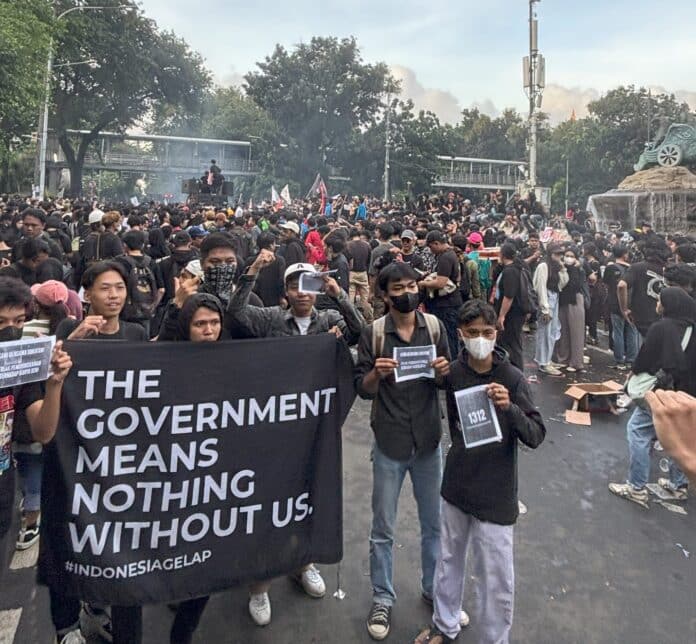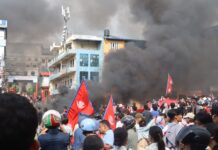Corrupt and arrogant capitalist politicians hide behind deadly state violence
Lance Ye, chinaworker.info and ISA
Since the end of August, Indonesia has been shaken by the largest protest movement since the fall of Suharto’s 32-year dictatorship in 1998. So far, the protests have left 10 people dead, more than 1,000 injured and over 3,000 arrested in a vicious police and army crackdown against the demonstrations.
Sparked by the privileges and corruption of the politicians, these protests are a continuation of the nationwide wave of ‘Dark Indonesia’ protests in February. When 21-year-old motorcycle taxi driver Affan Kurniawan was killed on 28 August by an armored police vehicle, the dam of public anger burst asunder, with parallels to the death of Tunisian street vendor Mohamed Bouazizi in 2011. His death became the trigger for a revolutionary movement against dictatorship that spread across the Arab world during the following months.
With the news of Affan Kurniawan’s murder, demonstrations spread from the capital Jakarta to dozens of cities in at least 32 of Indonesia’s 38 provinces, with tens of thousands of people taking to the streets. Indonesia is the world’s fourth most populous country (285 million people) spanning 5,000 kilometers from east to west.
The initial trigger was the decision on 15 August to give the 580 members of parliament, in addition to their already high salaries, a monthly “housing allowance” of 50 million rupiah (about US$3,000). This sum is equivalent to ten times the statutory minimum wage in Jakarta and more than 20 times the minimum wage in poor provinces. At a time of generalised austerity, with workers’ spending power squeezed, this incident showed the gulf separating out-of-touch pro-capitalist politicians from the masses. The DPR (House of Representatives) and MPR (People’s Consultative Assembly) are the “least trusted” institutions in the country according to recent surveys.
Austerity and tax increases
Tens of millions of Indonesian workers are bearing the brunt of president Prabowo Subianto’s austerity measures, soaring taxes, factory closures and layoffs, and a cost-of-living crisis. There have been around 20,000 layoffs per month in the first half of this year. With similarities to China, 16 percent of young people aged 15-24 are unemployed, more than double the rate in Thailand and Vietnam. Due to a lack of real jobs, millions are forced into the unregulated informal sector or “gig economy”, without employment contracts. 56% of the country’s workforce lack social security, medical and retirement cover.
Faced with grinding economic insecurity and hardship, a growing number of Indonesians are dreaming of “escape”. The hashtag #KaburAjaDulu (“Let’s escape”) garnered over 20 billion interactions in two months (primarily on X and TikTok), according to ABC (Australia). After the death of Affan Kurniawan, what began as a protest against “parliamentary privilege” escalated into a broader social uprising, targeting national and regional parliaments and politicians.
Protesters set fire to regional parliament buildings in West Nusa Tenggara, Pekalongan city in Central Java and Cirebon city in West Java, according to Reuters, while others stormed and looted the homes of at least four of the most hated MPs. Several police stations were reportedly also looted and burned. Regional governments have borne the brunt of Prabowo’s drastic budget cuts, with transfers from the national government slashed by around a quarter. This austerity has been passed on to the local population with tax increases and the cessation of various programs. Hence the anger specifically directed against these institutions.
Concessions and repression, but mostly repression
Prabowo has attempted to quell the protest wave with a mix of token concessions and more repression. On August 31st, Prabowo announced that all parties had “agreed” to withdraw some parliamentary allowances. He also briefly announced that he would cancel his attendance at China’s 3 September military parade to “focus on domestic affairs”. Despite this, he went. The National Human Rights Commission, a nominally independent organ, vaguely acknowledged that police used excessive force during the operations on the 25 and 28 August.
The government announced an investigation and the prosecution of the police officers involved. Prabowo made a high-profile visit to Affan Kurniawan’s family, offering an apology and “compensation” of 200 million rupiah (less than one month’s salary for an MP, for the loss of a 21-year-old’s life who was his family’s main breadwinner).
These attempts to blunt the mass anger were of course deeply hypocritical and people immediately saw through the ruse. Affan’s father categorically stated, “Billions of dollars won’t bring my son back.” Ultimately, only seven police officers were sentenced to 20 days of “special detention” – not prison, but detention at the police station, akin to being kept back after school. This mockery of justice further infuriated the public.
The chairman of the All-Indonesia Student Council declared these concessions “far from enough.” On 25 August, motorcyclists in Jakarta waved the flag of the Straw Hat Pirates from the manga series “One Piece” as a symbol of resistance against oppression. While taking a half-step backwards, offering a few superficial concessions, Prabowo has doubled down on repression and likened the mass protests to “treason and terrorism.” His trip to China was meant to send a message that the protests are now under control, but this remains to be seen.
Marxism is illegal
In last year’s presidential election in the world’s “third largest democracy”, right-wing populist Prabowo won a landslide victory with 59% of the vote. But given his government’s aggressive austerity policies, the country has already experienced multiple rounds of protests less than a year into his term, with some parallels to the situation in Argentina after Javier Milei came to power, but with a weaker workers’ movement.
Trade union membership is falling in Indonesia, at around 12% of the workforce today compared to 13% in 2017. The workers’ movement was brutally suppressed under the military dictatorship of Suharto (1965-98) and today Marxism and Communism are still illegal (this is one reason why anarchism, which is not banned, has grown significantly).
Since 1998, the so-called “democratic order” of Indonesian capitalism has failed to deliver democracy or even minimal economic security, instead enriching capitalist oligarchs while millions remain in poverty. The top 1% of Indonesians own 49% of the country’s wealth and 60% of the land. The poorest 40% own just 1.4% of the wealth. The new government is using huge budget cuts to “revive” the economy, while attacking the few remaining welfare benefits, such as education and healthcare. Prabowo’s deep austerity measures, “Prabowonomics”, hide behind some populist schemes such as his “free school lunch program”. This is used to justify this year’s 700 trillion rupiah in public budget cuts (including reducing the education budget by a quarter), but has also resulted in hundreds of food poisoning cases among schoolchildren.
Prabowo is also diverting funds into another flagship policy, his new sovereign wealth fund Danatara, a shift to more ‘state capitalist’ interventions. Danatara’s brief is to take over and transform the country’s SOEs (state-owned enterprises) into profit-making machines. Like several other Southeast Asian economies, this is linked to ongoing power struggles with ethnic Chinese capitalists who by some accounts own more than 80% of Indonesia’s biggest companies.
US-trained war criminal
Prabowo’s dark past has deepened public distrust: He was a US-trained (Fort Bragg) special forces general, who married the dictator Suharto’s daughter, and is accused of massacres in East Timor and the kidnapping and torture of anti-Suharto figures in 1998. Since taking office in November, he has shifted government and politics further to the right and authoritarianism.
In addition to his austerity drive he is pursuing an aggressive militarization policy (“big nation, strong military”), establishing 100 new army battalions (around 500 soldiers each) with plans for another 400. Prabowo’s amendments to the National Military Law in March opened the door for active-duty military officers to hold key government positions, expanding the number of civilian agencies in which military personnel can serve from 10 to 14, including the medical sector for example. This gives the army top brass more control over government policy and more money-making opportunities, further eroding Indonesia’s already fragile bourgeois democracy. This authoritarian drift was already advancing under Prabowo’s predecessor Joko Widodo, but the pace may now be speeding up.
Many on the Chinese internet are discussing and trying to follow the current wave of protests in Indonesia. While many are analyzing the causes and expressing sympathy and support for the protesters, others worry about a repeat of the tragedy of 1998, when the dying Suharto regime and Indonesia’s army instigated anti-Chinese pogroms in a last-ditch attempt to derail the revolt against the dictatorship.
Meanwhile, the Chinese Communist Party (CCP) regime repeatedly cites “non-interference in internal affairs” as a cover to safeguard its capitalist and imperialist interests (China has US$70 billion USD of state-backed, and US$94 billions of private investments in Indonesia), rolling out the red carpet for blood-stained politicians – Prabowo being a prime example. The CCP’s censorship of online discussion about the Indonesian massacres was intended both to conceal the memory of the 1989 crackdown in Beijing, and to maintain China’s geopolitical and economic power in Southeast Asia.
A leaderless struggle?
“It is unclear who, if anyone, is driving the protest movement that appears on its surface to have no core”, noted a Reuters report. Such a phenomenon is increasingly common especially in Asia – from Hong Kong 2019, to Sri Lanka 2022 and Bangladesh 2024. These mass struggles have been dominated by largely unorganised or loosely-organised but heroic youth with support from grassroots workers – mostly without trade union organisations or with little real engagement. These movements have mostly taken aim against corrupt political elites or dynasties, who of course are the most obvious face of the system, but have not fully grasped the role and connection between the political facade – parliament and government – and the economic dictatorship of the capitalists and billionaires who are the real power in the system of capitalism.
Recent scenes of young Indonesian protesters marching away with looted watches and even pets from the homes of corrupt politicians is reminiscent of the protesters who stormed the Sri Lankan president’s palace in Colombo and occupied his swimming pool. The anger and short-lived sense of delivering “justice” is understandable, but a movement for real change needs a clearer plan and must aim first at organising and then conquering real political power for the working class.
Key union leaders in Indonesia are tied to right-wing parties like the president’s. This is the case with Said Iqbal and the leadership of the KSP-PB (Labour Party) and union confederation KSPI. These union leaders can be pushed along by mass pressure to support strikes and protests, but only to slam on the brakes and sign rotten deals with the government at a later stage. The struggle for democratic unions and a new fighting leadership rooted in the working class and living on ordinary workers’ wages and conditions is a crucial element of the struggle.
The total failure of earlier promising attempts to create a mass left party, has created a huge vacuum. This is especially the case with the failure and collapse of the PRD (Partai Rakyat Demokratik), a workers’ party formed during the final years of Suharto’s dictatorship. Instead of fighting independently for workers’ candidates, the PRD, misadvised by some “left theoreticians”, adopted a “stages” theory to support the “democratic bourgeois” candidate Megawatti in the first “free” elections (1999). This led to the PRD’s eventual collapse, with several of its leading trade union profiles and former leaders opting for careers in the bourgeois establishment, abandoning the working class.
Rather than incorrectly believe that “no leadership” is an asset, and focus wholly on action rather than political ideas, what is needed is real democratic organisation around a clear program to take the struggle forward.
The current struggle has raised “17 + 8” demands (17 short-term and 8 long-term demands). Many of the demands are important and self-evident as a bottom line. These include the release of all detained protesters, return of troops to barracks, an independent investigation into Affan Kurniawan’s and other victims’ unlawful killings, and cancellation (the word used is “freeze”) of the parliamentarians’ pay increases and perks. As immediate minimum demands these are a beginning, but as a program to challenge a brutal anti-working class regime they are not enough. Other parts of the “17 + 8” demands are extremely vague such as the call for “reasonable wages to every workforce”, “fairer tax reform plan”, and for the government to “open dialogue with labor unions”.
Then there are other demands that contradict the real lived experience of the protesters and the mass of working people, such as the demand to “announce the commitment of political parties to side with the people during crisis” – but the capitalist parties exist to “side” with their class, never with the people. This is why as all history has shown the working class needs its own party. Some parts of this mixture of “long-term” but very limited reform demands, with more concrete immediate demands, feel like the handiwork of NGOs and academia rather than coming from the struggles in the streets. Unfortunately, this program falls far short of what the current knife-edge situation requires.
Democratic assemblies are needed to bring together the students, young workers, women workers and other constituent forces within the mass protests to decide a fighting strategy and demands. If the capitalists and their system remain in power then the corruption, autocratic politics, military control and police violence will not go away but rather reappear more viciously.
As seen with the eruption of mass struggles in other countries, Prabowo will attempt to derail and exhaust the movement by promising ‘X’ and ‘Y’ but this will be temporary, to defuse the threat from a mass movement. These promises will always be broken.
The working class cannot be satisfied with promises; a political alternative, workers’ party and program is needed, demanding the fall of Prabowo. For elected representatives to live on a workers’ salary with expenses publicly vetted and controlled, for a workers’ and poor people’s government, big wage increases and an end to outsourcing and precarious “gig sector” conditions. For public ownership and workers’ democratic control of the big companies and banks. Build democratic action committees in all workplaces, schools and local neighbourhoods, and prepare for a general strike of all workers.




